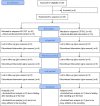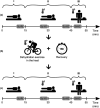Impact of sodium citrate ingestion during recovery after strenuous exercise in the heat on heart rate variability: A randomized, crossover study
- PMID: 35510322
- PMCID: PMC9069164
- DOI: 10.14814/phy2.15280
Impact of sodium citrate ingestion during recovery after strenuous exercise in the heat on heart rate variability: A randomized, crossover study
Abstract
Changes in hydration status influence plasma volume (PV) which is associated with post-exercise parasympathetic reactivation. The present study hypothesized that, after dehydrating cycling exercise in the heat (DE), stimulation of PV expansion with sodium citrate (CIT) supplementation would promote heart rate variability (HRV) recovery in endurance-trained men. Twelve participants lost 4% of body mass during DE. During subsequent 16-h recovery, participants consumed water ad libitum (CIT =5.5-L, PLC =5.1-L) and ate prescribed food supplemented with CIT or placebo in a randomized, double-blind, crossover manner. Relative changes in PV were assessed across DE and 16-h recovery. HRV was analyzed before and 16 h after DE in three conditions for altogether four 5-min periods: supine in a thermoneutral environment, supine in the heat (32°C, 46% relative humidity; 2 periods), and standing in the heat. A larger expansion of PV across 16-h recovery occurred in CIT compared to placebo trial (p < 0.0001). However, no between-trial differences appeared in HRV parameters (lnRMSSD, lnSDNN, lnLF/HF) in any 5-min period analyzed before or 16 h after DE (in all cases p > 0.05). Increases in HR (p < 0.001) and lnLF/HF (p = 0.005) and decreases in lnRMSSD (p < 0.001) and lnSDNN (p < 0.001) occurred following DE in both trials. Larger PV expansion induced by CIT supplementation after DE does not improve recovery of HRV at rest and has no influence on HRV responsiveness in endurance-trained men.
Keywords: dehydration; endurance athlete; exercise-heat stress; plasma volume.
© 2022 The Authors. Physiological Reports published by Wiley Periodicals LLC on behalf of The Physiological Society and the American Physiological Society.
Conflict of interest statement
The authors have no conflicts of interest to declare that are relevant to the content of this article.
Figures




Similar articles
-
Impact of sodium citrate ingestion during recovery after dehydrating exercise on rehydration and subsequent 40-km cycling time-trial performance in the heat.Appl Physiol Nutr Metab. 2018 Jun;43(6):571-579. doi: 10.1139/apnm-2017-0584. Epub 2018 Jan 11. Appl Physiol Nutr Metab. 2018. PMID: 29324186 Clinical Trial.
-
Influence of Sodium Citrate Supplementation after Dehydrating Exercise on Responses of Stress Hormones to Subsequent Endurance Cycling Time-Trial in the Heat.Medicina (Kaunas). 2019 Apr 12;55(4):103. doi: 10.3390/medicina55040103. Medicina (Kaunas). 2019. PMID: 31013820 Free PMC article. Clinical Trial.
-
Post-Exercise Recovery of Ultra-Short-Term Heart Rate Variability after Yo-Yo Intermittent Recovery Test and Repeated Sprint Ability Test.Int J Environ Res Public Health. 2020 Jun 7;17(11):4070. doi: 10.3390/ijerph17114070. Int J Environ Res Public Health. 2020. PMID: 32517382 Free PMC article.
-
Impact of acute sodium citrate ingestion on endurance running performance in a warm environment.Eur J Appl Physiol. 2015 Apr;115(4):813-23. doi: 10.1007/s00421-014-3068-6. Epub 2014 Dec 4. Eur J Appl Physiol. 2015. PMID: 25471273 Clinical Trial.
-
Dietary sodium citrate supplementation enhances rehydration and recovery from rapid body mass loss in trained wrestlers.Appl Physiol Nutr Metab. 2012 Dec;37(6):1028-37. doi: 10.1139/h2012-089. Epub 2012 Aug 8. Appl Physiol Nutr Metab. 2012. PMID: 22871128 Clinical Trial.
Cited by
-
Diminishing the Pathogenesis of the Food-Borne Pathogen Serratia marcescens by Low Doses of Sodium Citrate.Biology (Basel). 2023 Mar 26;12(4):504. doi: 10.3390/biology12040504. Biology (Basel). 2023. PMID: 37106705 Free PMC article.
References
-
- Banjar, W. M. , Gazzaz, J. , Langley, R. W. , Bradshaw, C. M. , & Szabadi, E. (2000). Effects of high ambient temperature on parasympathetically mediated cardiovascular reflexes in normal man. British Journal of Clinical Pharmacology, 50(4), 360–365. 10.1046/j.1365-2125.2000.00284.x - DOI - PMC - PubMed
Publication types
MeSH terms
Substances
LinkOut - more resources
Full Text Sources
Research Materials
Miscellaneous

